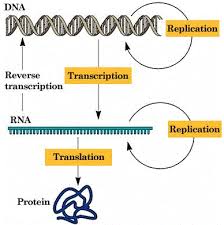A little discussion about the ribosomal RNA genes

I mentioned in the last post about the rRNA genes (also called rDNA loci). The reason why these are important starts with what is called the central dogma of molecular biology, which is that DNA -> RNA -> Protein. That means that the information for everything in your cell is contained within your DNA. That information is transcribed into RNA, which is chemically very similar to DNA. It is also mobile. It moves from the nucleus of your cells out into the cytoplasm where its information is translated into protein. The picture below, found at http://bytesizebio.net, illustrates this graphically. The way that the RNA is translated into protein is by something called the ribosome,
http://en.wikipedia.org/wiki/Ribosome . This ribosome is actually an RNA based machine, that is 3 RNA molecules do the actually synthesizing of the protein. These are called ribosomal RNAs, or rRNAs. Because every protein in the cell needs the ribosome and these rRNAs to be made, they are obviously found in very high abundance. The way this is possible is because they are in a very high copy number. Typically you have 2 copies of each gene, one from mom and one from dad. But you have 200 copies of these genes (100 from mom and 100 from dad). They are found in what we call head to tail repeats. This means they come right in a row with the end of one going right up against the start of the next, sorta like floats in a parade. The interesting thing about these genes is that in actively dividing cells, all 200 are turned "on". But as cells develop into more mature types, some are turned "off". Most commonly, half are turned off but I've also seen many cases where most are turned off.
Essentially, one can think of these as the engine that allows a cell to grow and divide. This has made the regulation of these genes very important to the study of severe metastatic tumors and cancer treatment. Because it seems that when a cell becomes cancerous, its less likely to become a life threatening and severely aggressive tumor unless its able to turn all these genes "on".
Its an interesting field of study to those of us, like myself, that are interested in basic molecular biological questions because of the problem that differentially regulated repeats pose to the study of the cell. Sequence is very important to biology. The sequence of DNA is what differentiates one gene from another. And from these sequences, we can understand how a gene is turned on and off. Most commonly, whenever you have identical DNA sequences, they behave identically. However, this is occasionally not true. In this instance, it is the crux of biologists like myself to determine how the cell can tell the difference between two identical sequences. This is a common theme in a study that has recently gained notoriety, called epigenetics.
No comments:
Post a Comment